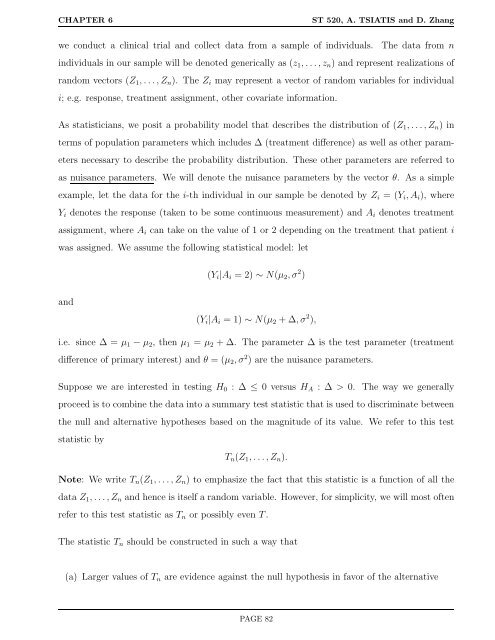ST 520 Statistical Principles of Clinical Trials - NCSU Statistics ...
ST 520 Statistical Principles of Clinical Trials - NCSU Statistics ...
ST 520 Statistical Principles of Clinical Trials - NCSU Statistics ...
You also want an ePaper? Increase the reach of your titles
YUMPU automatically turns print PDFs into web optimized ePapers that Google loves.
CHAPTER 6 <strong>ST</strong> <strong>520</strong>, A. TSIATIS and D. Zhang<br />
we conduct a clinical trial and collect data from a sample <strong>of</strong> individuals. The data from n<br />
individuals in our sample will be denoted generically as (z1, . . .,zn) and represent realizations <strong>of</strong><br />
random vectors (Z1, . . .,Zn). The Zi may represent a vector <strong>of</strong> random variables for individual<br />
i; e.g. response, treatment assignment, other covariate information.<br />
As statisticians, we posit a probability model that describes the distribution <strong>of</strong> (Z1, . . .,Zn) in<br />
terms <strong>of</strong> population parameters which includes ∆ (treatment difference) as well as other param-<br />
eters necessary to describe the probability distribution. These other parameters are referred to<br />
as nuisance parameters. We will denote the nuisance parameters by the vector θ. As a simple<br />
example, let the data for the i-th individual in our sample be denoted by Zi = (Yi, Ai), where<br />
Yi denotes the response (taken to be some continuous measurement) and Ai denotes treatment<br />
assignment, where Ai can take on the value <strong>of</strong> 1 or 2 depending on the treatment that patient i<br />
was assigned. We assume the following statistical model: let<br />
and<br />
(Yi|Ai = 2) ∼ N(µ2, σ 2 )<br />
(Yi|Ai = 1) ∼ N(µ2 + ∆, σ 2 ),<br />
i.e. since ∆ = µ1 − µ2, then µ1 = µ2 + ∆. The parameter ∆ is the test parameter (treatment<br />
difference <strong>of</strong> primary interest) and θ = (µ2, σ 2 ) are the nuisance parameters.<br />
Suppose we are interested in testing H0 : ∆ ≤ 0 versus HA : ∆ > 0. The way we generally<br />
proceed is to combine the data into a summary test statistic that is used to discriminate between<br />
the null and alternative hypotheses based on the magnitude <strong>of</strong> its value. We refer to this test<br />
statistic by<br />
Tn(Z1, . . ., Zn).<br />
Note: We write Tn(Z1, . . .,Zn) to emphasize the fact that this statistic is a function <strong>of</strong> all the<br />
data Z1, . . .,Zn and hence is itself a random variable. However, for simplicity, we will most <strong>of</strong>ten<br />
refer to this test statistic as Tn or possibly even T.<br />
The statistic Tn should be constructed in such a way that<br />
(a) Larger values <strong>of</strong> Tn are evidence against the null hypothesis in favor <strong>of</strong> the alternative<br />
PAGE 82
















